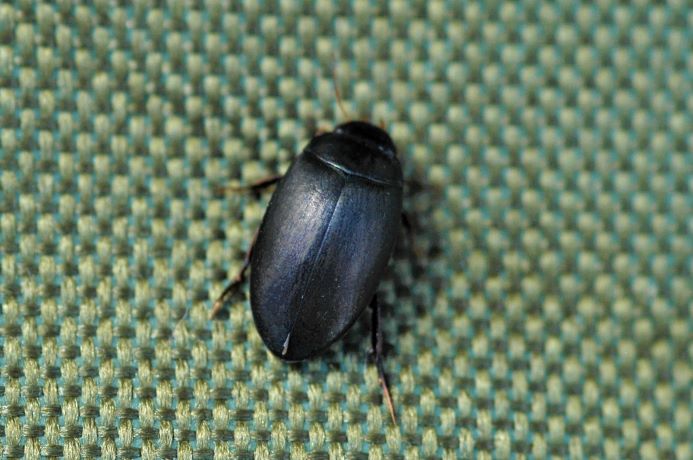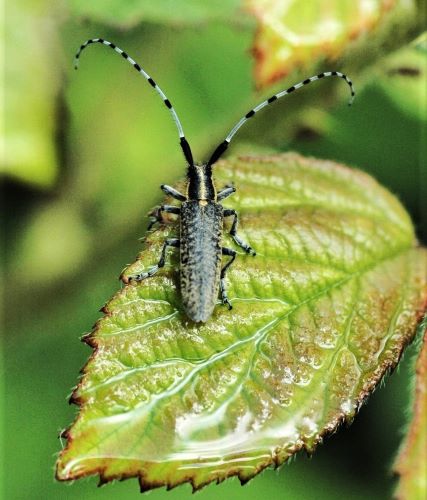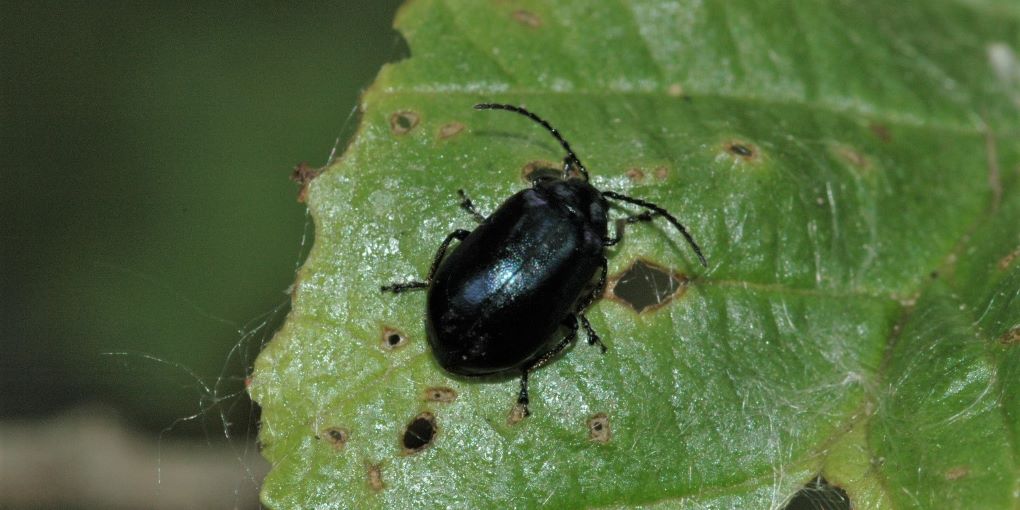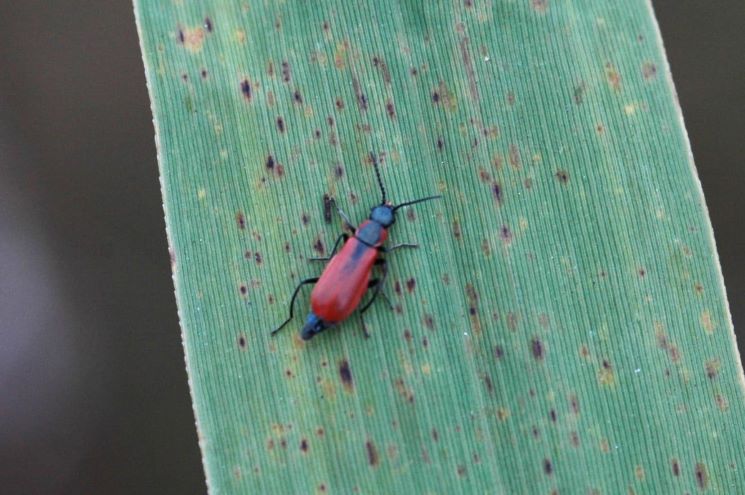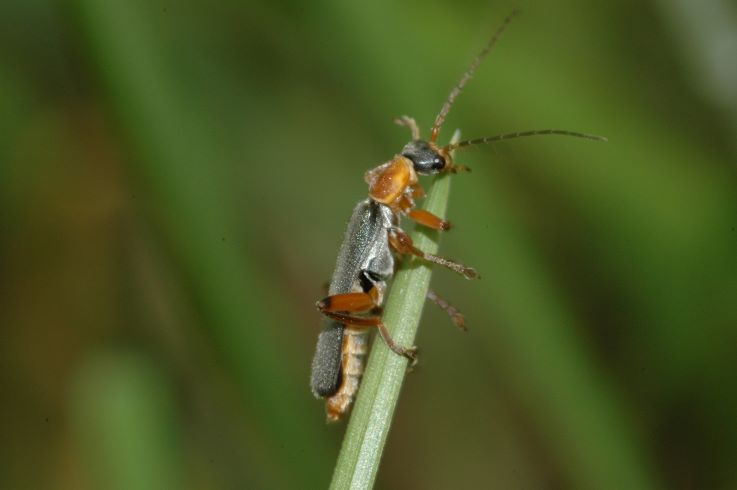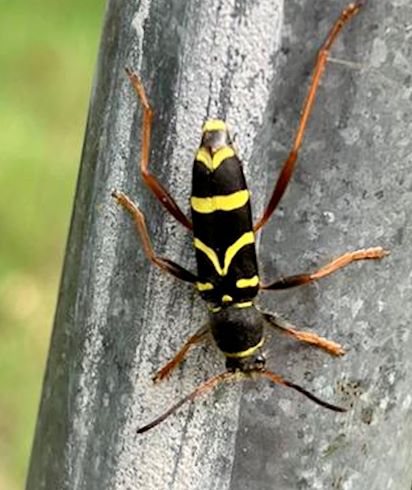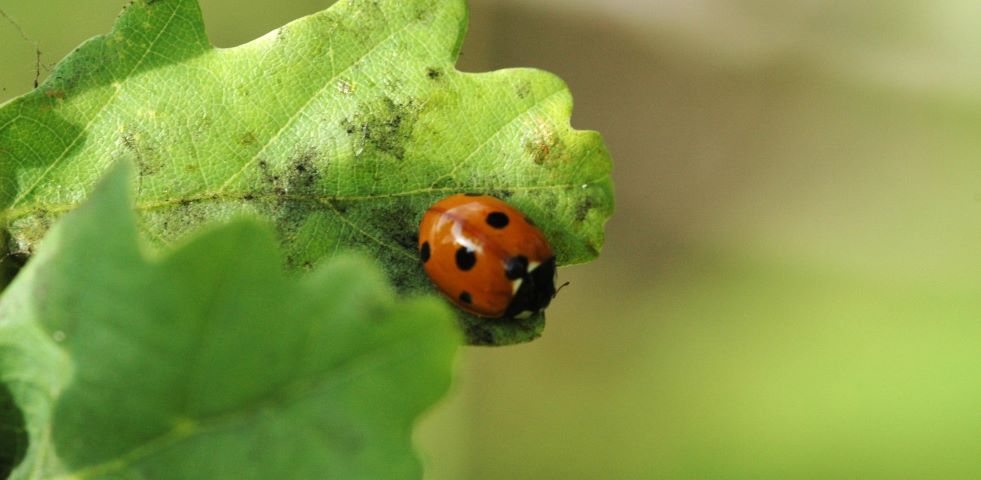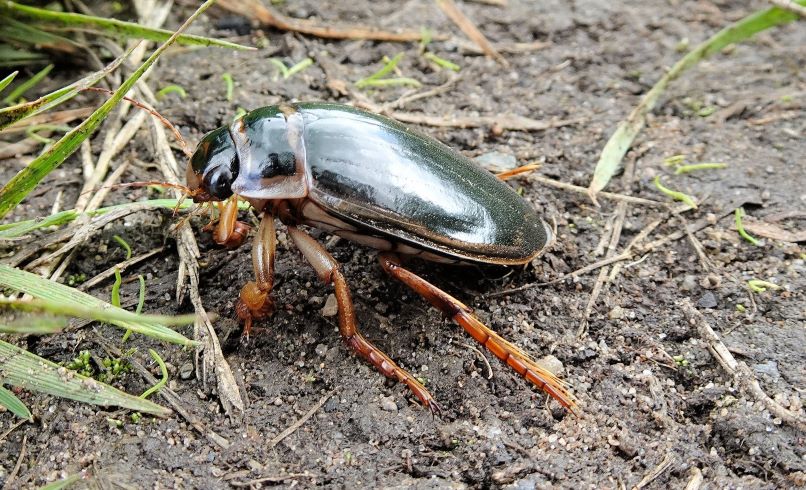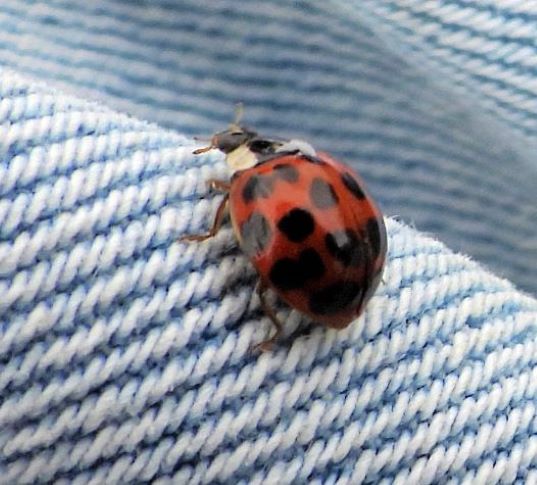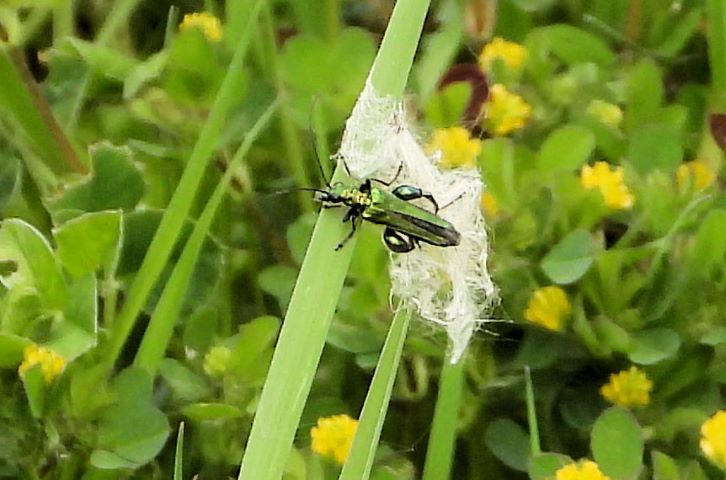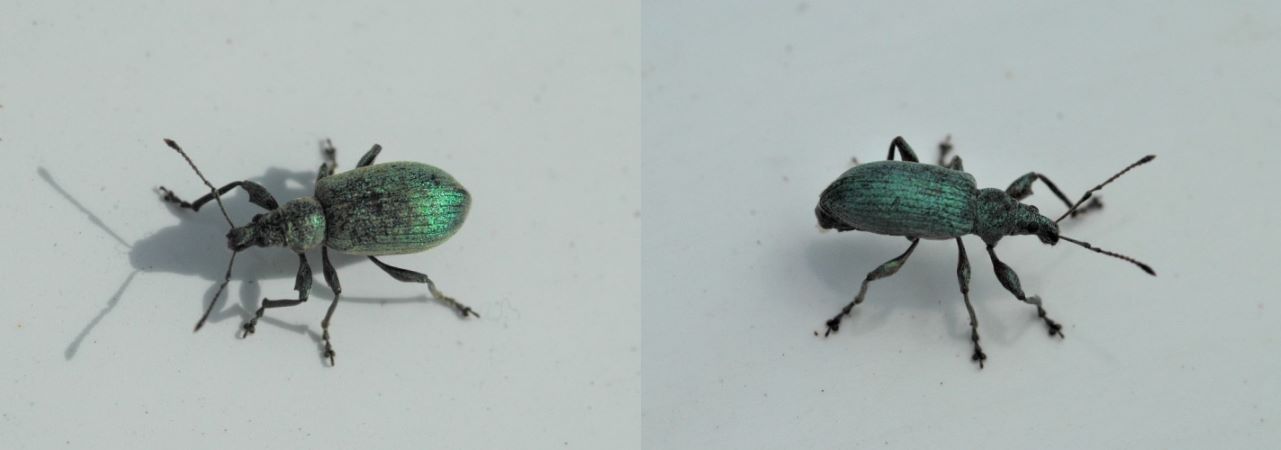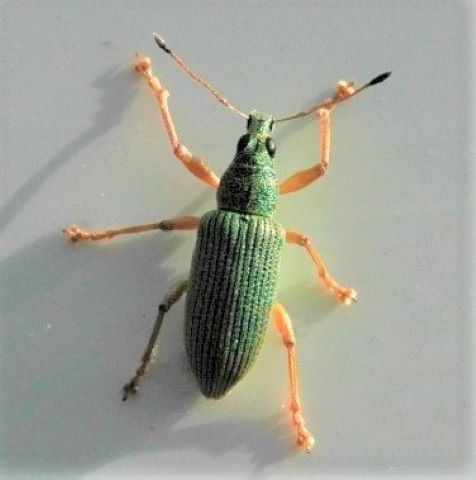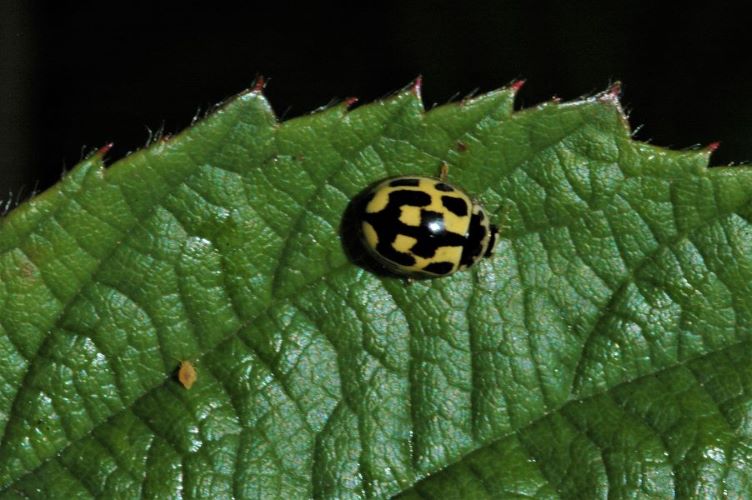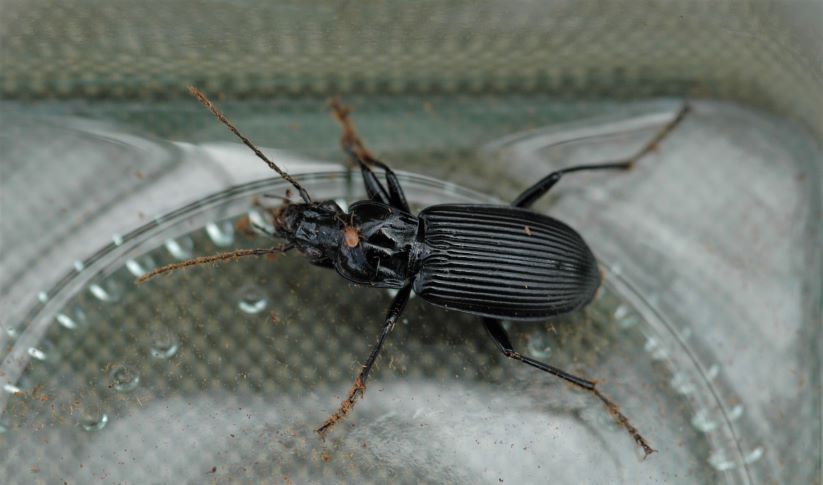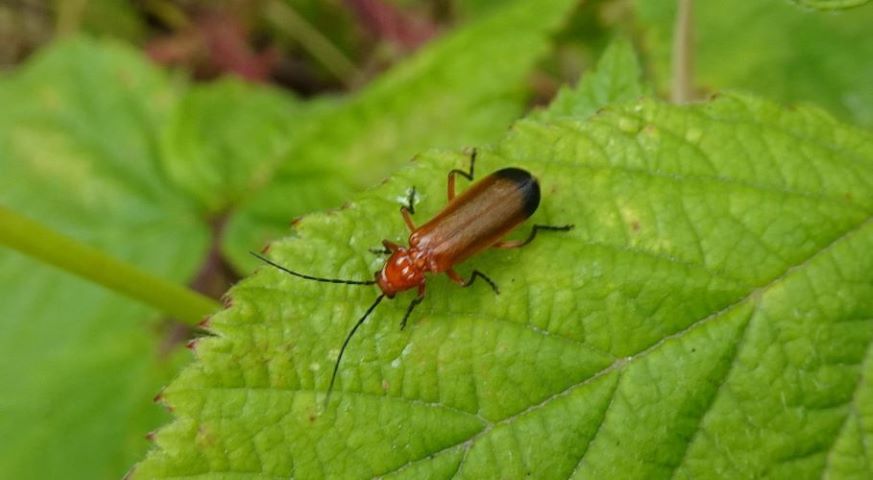Beetle & Weevil Species Recorded At Woolston Eyes
This section records all the species identified within the ‘Coleoptera’ the largest order of insects, representing around 40% of the known insect species with some 4,000 found in the UK.
Species of Beetles & Weevils Recorded at Woolston Eyes rev.Feb2023
The species list above has been compiled from records extracted from the following surveys;
Acrotrichis henrici
Family: Ptiliidae Common Name: Acrotrichis Henrici - small, measuring c. 1.5mm in overall length, typically brown or black and found in leaf litter, moss and decaying organic matter.
Adalia bipunctata
Family: Melyridae Common Name: 2 Spot Ladybird - common with two colour variations, most are red with two black spots but can be black with two red spots. The legs are black and the toes extend to the edge of the wing case. Found on soft parts of plants and trees where it feeds on aphids.
Adalia decempunctata
Family: Melyridae Common Name: 10 Spot Ladybird - does not always have 10 spots and young specimens are pale brown before they develop the orange colouration. The legs are brown. Found on soft parts of plants and trees where it feeds on aphids.
Adrastus pallens
Family: Elateridae Common Name: Adrastus pallens - 5mm long with orange-brown wing cases, legs and long antennae. The wing cases have a dark stripe down the middle and pits are visible in rows along their length. The head and pronotum are black. Found in wetland habitats but also hedgerows and rough grassland.
John Blundell No.1 bed 23/08/2021
Agabus bipustulatus
Family: Dytiscidae Common Name: Agabus bipustulatus - possibly the UK’s commonest water beetle, all black and 10mm long and is smoothly rounded in contour. Although there is some brown on the mid and hind legs the front legs and antennae are all pale brown. It is carnivorous and feeds in and out of water. Males are glossy and females are dull.
John Blundell No.1 bed 01/06/2022 on Bramble hedgerow
Agapanthia villosoviridescens
Family: Cerambycidae Common Name: Golden-bloomed Grey Longhorn Beetle - a distinctive larger beetle at 20mm length with a golden iridescent wash to the upper body and dark and light banding on the antennae. Feeds on umbellifers and active May to July in moist grassland, hedgerows and similar margins.
Agathidium varians
Family: Leiodidae Common Name: Agathidium varians - a small beetle at c.3mm with adults able to curl up into an almost perfect sphere. Shiny dark brown to black with lighter brown shade on the head and pronotum margins.
John Blundell No.1 bed 27/05/2022 on Alder
Agelastica alni
Family: Chrysomelidae Common Name: Alder Leaf Beetle - a distinctive metallic blue-black beetle around 7mm long and feeds mainly on Alder.
Agriotes acuminatus
Family: Eleateridae Common Name: Agriotes acuminatus - a brown click beetle. The head is generally darker black/brown than the brown wing cases which have ridges running down their length. The legs and antennae are a light brown colour. Active May to July mainly in deciduous woodland but also scrub, agricultural land and grassland.
Amara aulica
Family: Carabidae Common Name: Amara aulica - a ground beetle, black with metallic bronze lustre, herbivorous.
Amara fulva
Family: Carabidae Common Name: Amara fulva - widespread but localised to dry sandy habitats close to water. 8 to 10mm long dull yellowish-brown with greenish iredescence.
Amara plebeja
Family: Carabidae Common Name: Amara plebeja - a widespread and generally common, 6 to 8mm long and shiny metallic bronze in colour. Found in damper open margins but overwinters in drier more wooded areas.
Amara tibialis
Family: Carabidae Common Name: Amara tibialis - locally common in southern and central England becoming more coastal and western moving north. 4 to 6mm long with a bright metallic brassy colouration in well vegetated habitats.
Anaspis frontalis
Family: Scraptiidae Common Name: Anaspis frontalis - generally abundant in England found on various flowers, especially Hawthorn early in the season in May. Small at 2.5 to 5mm but look elongated. Black in colour but the front of the head and front legs yellow.
Anaspis maculate
Family: Scraptiidae Common Name: Anaspis maculate - common in England, small at 2.5 to 3mm but elongated and pale orange-brown. Found in woodland and woody margins and feed on pollen on a number of flowers, Hawthorn, Elder and Hogweed being common.
Anaspis thoracica
Family: Scraptiidae Common Name: __Anaspis thoracica_ - fairly common in England, 3 to 4mm long bicoloured, the wing cases are dark blackish and the thorax and head a pale brown. They develop in decaying wood but adults feed on pollen on flowers.
Anisosticta novemdecimpunctata
Family: Coccoinellidae Common Name: Water Ladybird - typical colouration is a pale orangish yellow-brown with many black spots. Highly variable on spot intensity and size as some fuse. Elongate-oval in shape and 3-5mm long, feed on aphids and inhabit leaf litter in Typha and Phragmites, overwintering in the stems.
John Blundell No.1 bed 27/08/2021
Anthocomus rufus
Family: Melyridae Common Name: Anthocomus rufus - a small, 5 to 6mm red and black beetle associated with damp places, reed beds and other water margins. The red wing cases (elytra) are shorter than the body which is dark with black on the head and thorax. Feeds on pollen and smaller insects on flowers.
Athous haemorrhoidalis
Family: Elateridae Common Name: Athous haemorrhoidalis - a common click beetle across England, 10-15mm long with an elongated form with black head and thorax and brown to red-brown wing cases. The beetle is covered in short fine brown hairs and feeds on pollen on a number of flowers, umbellifers being common.
Brachypterus glaber
Family: Kateretidae Common Name: Brachypterus glaber - small at 2mm long with shiny black upper surface which is densely pitted and no metallic iridescence. The wing cases do not cover the rear of the abdomen and the legs are black. Feeds on Nettle flowers.
Byturus ochraceus
Family: Byturidae Common Name: Byturus ochraceus - common and widespread in England, 3.5 - 5mm elongated oval shaped beetle, mid-brown colour, including the legs, and covered in brown hairs on upper surface. Very similar to B. tormentosus but is slightly larger, to 5mm and slightly darker. Found feeding on many flowers.
Byturus tormentosus
Family: Byturidae Common Name Raspberry Beetle - very similar to B. ochraceous above but smaller 3.2 - 4mm and slightly lighter brown in colour. Is also common and widespread in England. Larvae develop on Raspberry, Blackberry and Loganberry feeding on the growing fruit.
Cantharis cryptica
Family: Cantharidae Common Name: Cantharis cryptica - a soldier beetle, widespread and common throughout England. Size, 7-8.5mm, elongated shape, wing cases orange-brown, hairy, the head and thorax more orange, has black rings above the knees and all orange palps. Found in grassy places, feeds on umbrel flowers, trees and bushes.
Cantharis decipiens
Family: Cantharidae Common Name: Cantharis decipiens - a soldier beetle, 7.5-8.5mm, widespread and common throughout England. Yellowish-brown in colour except hind legs blackish, rear of the head black and a butternut squash shaped black patch on the pronotum. Found amongst trees and shrubs, particularly fond of Hawthorn flowers.
Cantharis figurata
Family: Cantharidae Common Name: Cantharis figurata - a widespread and fairly common solider beetle in England, 6-8mm. An orangey colour, partial black head, black mark, sometimes reduced to spots, on the pronotum and dark femurs changing to orange before the tibia. Found in wet meadows, damp woodland, waterside vegetation.
John Blundell No.1 bed 27/05/2022
Cantharis nigricans
Family: Cantharidae Common Name: Cantharis nigricans - widespread and common in England, 10mm long, dark wing cases which look grey from the coating of hairs, orange-brown pronotum and legs, the hind femur have a broad black band above the tibia joint. Attracted to flowers where their prey of smaller insects feed.
David Riley No.1 bed 06/05/2022
Clytus arietis
Family: Cerambycidae Common Name: Wasp Beetle - a striking and unmistakable beetle black with yellow transverse stripes and up to 18mm in length. The legs are orange-brown grading darker towards the abdomen. The adults feed on pollen and nectar but breed in decaying wood and are active from May to August.
Chrysolina polita
Family: Chrysomelidae Common Name: _ Chrysolina polita_ - Widespread and fairly common in England, ovoid shaped, 6-9mm long, wing cases pitted, bright reddish-chestnut, pronotum, head and legs are a metallic iridescent green. Found in varied habitats but all kinds of wetlands with host plants, Mint, Nettle, Dead Nettles with others.
John Blundell No.1 bed 23/07/2021
Coccinella septempunctata
Family: Cocinellidae Common Name: 7 Spot Ladybird - a very familiar and common ladybird, red with seven black spots, three on each wing case and one at the back split between the wings. The pronotum is black with two white patches on the front edge and two smaller ones on the head. Active March to October and hibernate over winter. Both the adult and larvae feed on aphids.
Crepidodera aurata
Family: Chrysomelidae Common Name: Willow Flea Beetle - widespread and frequent in England except the northern counties Northumberland and Cumbria. Tiny at 3mm it is bi-coloured, metallic green and pitted wing cases, reddish copper-bronze head and pitted pronotum. Legs yellow but hind femur are dark. Found on Willow species.
Crepidodera aurea
Family: Chrysomelidae Common Name: Crepidodera aurea - widespread and relatively common throughout England. 2.5-4mm long, ovoid shaped, whole upper surfaces a bright iridescent blue-green and pitted. Legs are orange-brown with femurs tending darker. Found on Willow species in a variety of habitats but all types of wetlands.
Ctenicera cuprea
Family: Elateridae Common Name: Ctenicera cuprea - * a widespread but only locally common in northern England, scarce south of the Midlands. 12-17mm, pointedly elongated, ridged wing cases, has an iridescent bronze upper or bronze at the ends and brown or coppery-red in the central wing case area. Legs black. On heaths, grassland, moorland on grass heads, umbellifers and thistle flowers.
Denticollis linearis
Family: Elateridae Common Name: _ Denticollis linearis_ - common across England, 9-13mm, elongated, wing cases can be variable in colour, yellow-brown to orange-brown to very dark but the pronotum is always orangey. Found meadows, woodland rides, scrub, feeds on smaller insects, larvae and live wood.
John Blundell No.1 bed 24/07/2023 male
Dyticus marginalis
Family: Dytiscidae Common Name: Great Diving beetle - an aquatic diving beetle which live in freshwater, still or slow flowing. One of our largest beetles, to 30mm and oval shaped, are dark coloured above and yellow-orange underneath , as are the legs. Males have shiny wing cases whilst females are grooved.
Gastrophysa viridula
Family:Chrysomelidae Common Name: Green Dock Beetle - widespread and common in England, 4-6mm, ovoid, overall a bright metallic green with blue, golden or brassy tones. Found on Dock species and on vegetation in the vicinity of host plants.
Gliscrochilus sp.
Family: Nitidulidae Common Name Unidentified - three species occur in Britain, G. quadripunctatus, G. quadriguttatus and G. hortensis. They are blackish with two to four yellow, orange or reddish spots on the wing cases and range from 3-6mm in length. The specimen recorded was not examined to confirm the species. Found on decaying and fermenting organic matter generally wood and fruits.
Hallomenus binotatus
Family: Tetratomidae Common Name: a locally common beetle but with a scattered distribution in England, generally in Midlands and southern counties. 3.5-6mm, all brown but generally paler around the shoulders, pronotum and legs. Pointedly elongated and found on or in tree fungi on a range of deciduous trees.
John Blundell No.1 bed 08/10/2021
Harmonia axyridis
Family: Coccinellidae Common Name: Harlequin Ladybird - a very familiar species which is highly variable in both colour and markings. It is an alien species, larger than our native ladybirds at 8mm. It is active from April to October and hibernates over winter and predates on smaller insects, larvae and other ladybirds.
Hemicrepidius hirtus
Family: Elateridae Common Name: Hemicrepidius hirtus - a large click beetle at 13-17mm and elongated oval shaped. It is all black with a covering of silvery hairy down with ridged wing cases. Widely distributed from southern to northern England and fairly common in varied habitats.
Lagria hirta
Family: Tenebrionidae Common Name: Lagria hirta - common in sandy areas mainly southern England, more scattered north of the Humber and Mersey. Size, 7-10mm, black head, pronotum and legs and yellowish-brown wing cases which are bristly hairy and widely oval for the head size. Found on open flowers, composites and carrots.
Malachius bipustulatus
Family: Melyridae Common Name: Common Malachite Beetle - widespread and common in England. 5.5-6mm, metallic emerald green-bronze wing cases, pronotum and head. There are two red spots on rear and abdomen extends beyond wing cases. Front of pronotum has thin red edges. Found on flowers and grasses feeding on other insects.
Meligethes aeneus
Family: Nitidulidae Common Name: Meligethes aeneus - widespread and abundant in England, size 2-2.7mm, an ovoid shaped beetle, metallic green, blue or violet colour, black looking on dull days, with dark legs except front pair which are lighter and clubbed antennae. Found on flowers were they feed on pollen, particularly yellow flowers.
Nebria brevicollis
Family: Carabidae Common Name: _ Nebria brevicollis_ - a large black or dark brown beetle 10-14mm, has a broad pronotum, mid-brown legs and antennae although the femurs are generally slightly darker. Can be indistinguishable from N. salina without hand lens to determine _N. brevicollis _ fine hairs on hind tarsi. Found in woodland especially under stones. Common and widespread in England.
Neocrepidodera transversa
Family: Chrysomelidae Common Name: Neocrepidodera transversa - a widespread and common flea beetle (jump on disturbance) in England. Size 4.5mm, generally pale brown to orange-brown with pitting in a random manner and a transvers groove across the pronotum. Legs darker than femurs. Found mainly on Thistles.
John Blundell No.1 bed 13/05/2022
Oedemera nobilis
Family: Oedemeridae Common Name: Swollen-thighed Beetle - to 10mm long this is a striking metallic green beetle. The males have swollen femurs on the hind legs, which the females do not. The wing cases are pointed and gape open towards the rear when folded. This is a pollen feeder and is found in flower rich areas from April to September.
Phaedon tumidulus
Family**: Chrysomelidae Common Name: Celery Leaf Beetle - common in lowland England, small, 3-4mm, entirely shiny black with a green or brassy iridescence. except the claws which are red and the underside of the basal two antennae segments. Oval in shape and finely pitted in longitudinal rows. Mainly found on umbellifers, Hogweed in particular.
Philonthus succicola
Family: Staphylinidae Common Name: Philonthus succicola - a rove beetle, predatory on other insects, elongated body, head long and with pronotum a metallic green or bronze iridescence. The stunted wing cases and abdomen are black. Found in carrion, dung and compost.
John Blundell No.1 bed 23/05/2022 left male, right female, on grass, bramble & nettle hedgerow under gorse & hawthorn
Phyllobius maculicornis
Family: Curculionidae Common Name: Green Leaf beetle - a green leaf weevil which requires closer examination to separate the nine similar species. For P. maculicornis the ID keys are; front femora (thighs) have a ‘tooth,’ their base colour is dark not pale, the tibia are finely hairy and the body scales which give the iridescent green colour are elongated. Found from April to August in habitats that have mixed deciduous tree species.
Phyllobius pomaceus
Family: Curculionidae Common Name: Green Nettle Weevil - a common, widespread weevil 7-10mm, entire body and legs covered in green elongated scales (x50) which get abraded over time revealing the black body. Strong front femur tooth, legs generally dark and the rostrum (front of head) is longer than wide. Found on nettles in varied habitats.
John Blundell No.1 bed 23/05/2022 on grass, bramble & nettle hedgerow
Polydrufus formosus
Family: Curculionidae Common Name: Green Immigrant Leaf Beetle - an iridescent green weevil 5 to 6mm in length and pale legs which can be coated in displaced green scales. Confusion with the smaller Pale Green Weevil P. impressifrons is possible but is 20% larger has stronger lined wing cases, a longer, narrower face and noticeable larger eyes.
John Blundell No.1 bed 10/06/2022 on bramble scrub
Propylea quattuordecimpinctata
Family: Coccinellidae Common Name: 14 Spot Ladybird - Common across England and Wales, scarce in Scotland, there is variation in the body colour and shape and size of the black spots. Frequents shrubs and tall sward.
Psyllobora vigintiduopunctata
Family: Coccinellidae Common Name: 22 Spot Ladybird - the brightest of the UK yellow ladybirds, always has 22 spots which seldom coalesce. It is small at 3-4.5mm and there are two colour variations, one with a yellow pronotum and one were it is white. Fairly frequent in England, feeds on mildew fungi low down in vegetation or on soil surface.
Pterostichus madidus
Family: Carabidae Common Name: Black Clock Beetle - very common and widespread over England, size 13-18mm, black body and legs although a form has reddish legs, large head and pronotum hind angles are smoothly rounded. Found in grass, leaf litter, under bark and logs etc. feeding as scavengers or predators of other insects and molluscs.
Pterostichus melanarius
Family: Carabidae Common Name: Pterostichus melanarius - common and widespread in England, 13-17mm, robust and entirely shiny black except for the claws which are reddish-brown. Short antennae reaching to rear of pronotum which is wider at the head and toothed hind angles. Habitat, almost exclusive terrestrial predators.
John Blundell No.1 23/08/2021 found in understory litter
Pterostichus niger
Family: Carabidae Common Name: Pterostichus niger_ - common and widespread in England. 15-20mm long, all shiny black except for the reddish leg spines and end claws. The pronotum is slimmer than similar species, widest in front of the middle. Found on the ground under debris, dead wood or rank vegetation, predatory on other insects.
John Blundell No.1 bed 04/07/2022
Rhagonycha fulva
Family: Cantharidae Common Name: Common Red Soldier Beetle - a shiny orange-brown beetle to 10mm in length with black antennae and bar across the tips of the wing cases. Feeds on pollen and smaller insects, aphids in particular, and prefers open flowers especially Hogweed and other umbellifers.
Rhagonycha testacea
Family: Cantharidae Common Name: Rhagonycha testacea - generally common and widespread in England, 5-6mm, head black, pronotum yellowish-brown with a broad black central stripe. Wing cases and legs yellowish-brown. Found in woodland, damp and marshy ground, they are predatory feeding on foliage and flowers especially Hawthorn.
Trichocellus placidus
Family: Common Name: Trichocellus placidus - localised but widespread in England, 4.5-5mm, brown-black wing cases, brown legs, head darkest. Found on ground amongst reed litter in marshes, fens and slow-moving waterways.

